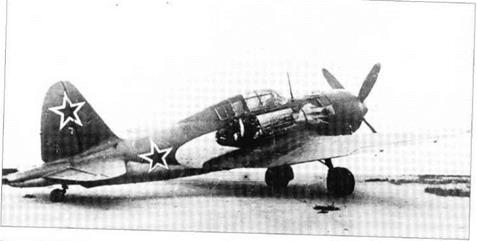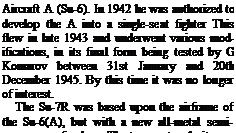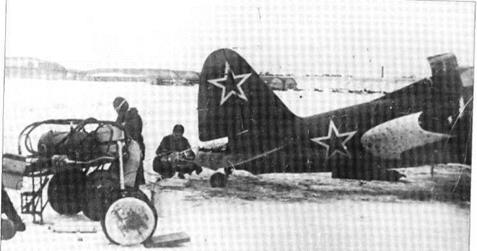Sukhoi Su-7R
![]()
![]()


Purpose: To create a mixed-power (piston engine plus rocket) fighter.
Design Bureau: OKB of Pavel Osipovich Sukhoi, Moscow. Note: this aircraft was not related to the later Su-7 jet fighter.
Having in 1941 seen the Su-2 attack bomber accepted into production, Sukhoi subsequently never dislodged the IL-2/IL-10, despite the excellence of different versions of
was replaced by a single-seat cockpit with a unged canopy with a fairing behind it. An additional fuel tank replaced the internal weapons bay, and the large-calibre wing guns were removed, the armament being three synchronized ShVAK 20mm cannon each with 370 rounds. At first the ASh-71 type engine was retained, but this was soon replaced by a smaller and less-powerful ASh – 82FN, rated at l,850hp on 10o-octane fuel driving an AV-9L four-blade propeller. In 1944 aTK-3 turb o sup ercharger was added on each side, and an RD-lKhZ rocket engine was installed in a new extended tailcone. As described previously, this Dushkin/Glushko engine had a single thrust chamber burning the same petrol (gasoline) as the piston engine, which ignited hypergolically (instant reaction) when mixed with RFNA (red fuming nitric acid). The acid was housed in an additional tank behind the cockpit, with access through a dorsal hatch. This tank gave a continuous burn time of about four minutes. When rocket power was selected, the propellants were fed at a rate of 1.6kg (3.5 Ib) per second, giving a thrust of300kg (661 Ib) at sea level and about 345kg (761 Ib) at high altitude.
By 1945 this aircraft was no longer competitive, and the rocket engine never went into production. In any case, during a practice for the first post-war air display in late 1945 the rocket engine exploded, casing a fatal crash.
3,250kg 7,1651b
480/50/1 80 1,058/110/397Ib
4j36°kg 9,612 Ib

|
|
|
|











